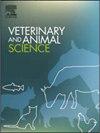Therapeutic efficacy of common anthelmintics used in the control of gastrointestinal nematodes in naturally infected sheep in Bishoftu, Central Ethiopia
IF 1.9
Q2 AGRICULTURE, DAIRY & ANIMAL SCIENCE
引用次数: 0
Abstract
Nematode parasites are a constraint on animal production and welfare. Anthelmintic resistance (AR) rigorously threatens the possible use of parasite control methods. Hence, this study aimed to assess the anthelmintic use practices of sheep farmers and evaluate the efficacy of common anthelmintics for gastrointestinal nematodes (GINs) in sheep in Bishoftu, Central Ethiopia. A survey was conducted with 100 randomly selected sheep farmers to gather information on anthelmintic use practices. Additionally, 90 nematode-infected sheep were selected for efficacy testing of the treatments. The sheep were chosen if the eggs per gram (EPG) was ≥ 150 in faeces and randomly assigned to three treatment groups (30 animals per group). Group 1, Group 2, and Group 3 were treated with ivermectin, albendazole, and tetramisole, respectively. Faecal samples were collected on days 0 (pretreatment) and 7 and 14 (after treatment). The modified McMaster method was used to count the eggs and fifty multiplication factor to estimate the EPG. The faecal egg count reduction test (FECRT) was utilized to assess the efficacy of the anthelmintics on day 14. The survey revealed that ivermectin was the most regularly (54 %) utilized anthelmintic to treat sheep nematodes, followed by albendazole (28 %) and tetramisole (15 %). The respondents also reported that the choice of anthelmintics was related to the prescription of veterinarians (52 %), color (23 %), affordability of price (14 %), and availability (11 %). The FECRTs on the 14th day were 87.7, 75.7, and 77.0 % for ivermectin, tetramisole, and albendazole, respectively. Although nematodes have developed resistance to all the tested anthelmintics, there was a significant (p < 0.001) reduction in the faecal egg count (RFEC) after treatment. During pretreatment, Hemonchus, Trichostrongylus, Teladorsagia, Cooperia, Trichuris, Bunostomum, Strongyloides, Chabertia, Esophagostomum, and Nematodirus and after treatnment Hemonchus, Trichostrongylus, Teladorsagia, and Trichuris were detected. The results revealed that gastrointestinal nematodes (GINs) in sheep have developed resistance to the tested anthelmintics.
埃塞俄比亚中部比绍夫图常用驱虫药控制自然感染绵羊胃肠道线虫的疗效
线虫寄生虫是动物生产和福利的制约因素。驱虫抗药性严重威胁着寄生虫控制方法的应用。因此,本研究旨在评估埃塞俄比亚中部比绍夫图(Bishoftu)牧羊农民的驱虫做法,并评估常见的驱虫药对绵羊胃肠道线虫(GINs)的效果。对随机抽取的100名牧羊农户进行了调查,以收集有关驱虫药使用做法的信息。此外,还选择了90只感染线虫的绵羊进行治疗效果试验。选取粪便中每克鸡蛋(EPG)≥150只的羊,随机分为3个处理组(每组30只)。组1、组2、组3分别给予伊维菌素、阿苯达唑、四氟咪唑治疗。于第0天(预处理)、第7天和第14天(处理后)采集粪便样本。采用改良的麦克马斯特计数法和50倍乘法估计EPG。第14天采用粪卵计数减少试验(FECRT)评估驱虫药的效果。调查显示,伊维菌素是治疗绵羊线虫最常用的驱虫药(54%),其次是阿苯达唑(28%)和四甲咪唑(15%)。受访者还报告说,驱虫药的选择与兽医处方(52%)、颜色(23%)、价格可承受性(14%)和可获得性(11%)有关。第14天,伊维菌素、四氟咪唑和阿苯达唑的fecrt分别为87.7、75.7和77.0%。尽管线虫已经对所有测试的驱虫剂产生了耐药性,但存在显著的(p <;0.001)治疗后粪卵数(RFEC)减少。预处理前后分别检测Hemonchus、tricho圆线虫、Teladorsagia、Cooperia、Trichuris、Bunostomum、strongyides、Chabertia、esophageal stomum和nematovirus,治疗后分别检测Hemonchus、tricho圆线虫、Teladorsagia和Trichuris。结果表明,绵羊胃肠道线虫(GINs)对所试驱虫药产生了耐药性。
本文章由计算机程序翻译,如有差异,请以英文原文为准。
求助全文
约1分钟内获得全文
求助全文
来源期刊

Veterinary and Animal Science
Veterinary-Veterinary (all)
CiteScore
3.50
自引率
0.00%
发文量
43
审稿时长
47 days
 求助内容:
求助内容: 应助结果提醒方式:
应助结果提醒方式:


